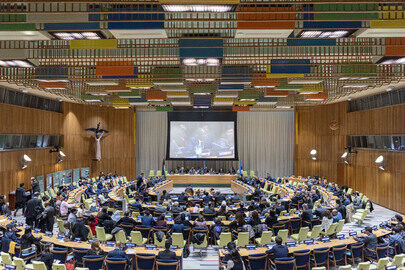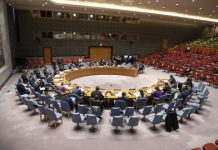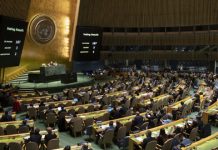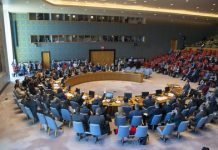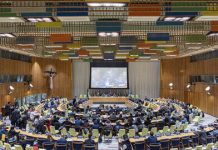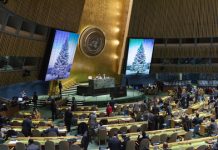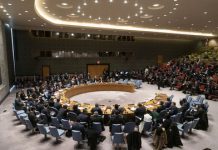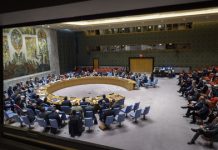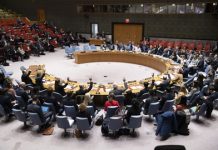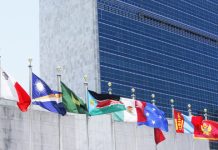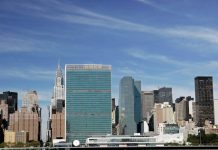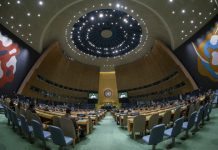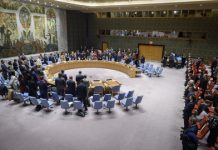Since the fierce bombardment of Gaza by Israel began in October 2023, in response to a deadly Hamas attack on the country, over 45,000 Palestinians have been killed, and over 100,000 injured.
The vast majority of Gazans, around 90 per cent, are internally displaced, forced to relocate several times to avoid airstrikes and fighting. Meanwhile, they struggle to find food or shelter: hundreds of thousands of homes have been destroyed, and 345,000 people are facing catastrophic levels of food insecurity.
Mr. Dumont shared his vivid reflections on the dire situation in Gaza shortly after his return from a mission to the Occupied Palestinian Territory:
“‘I need food, man’, Abdul Rahmen told me. We were in the southwestern Gazan city of Khan Younis, where men ladled out steaming rice into bowls thrust out by a desperate crowd. One boy was crying, afraid the food, supplied by the World Food Programme (WFP), would run out before his turn.
‘I was ambitious. I had dreams’, Rahmen said, describing expectations as shattered as the buildings around us. ‘But I need food. I can’t buy bread’.
I had arrived in Gaza the day before, making a 10-hour journey from Amman on a bus packed with humanitarian workers. Some of that time was spent waiting at Israel’s Kerem Shalom border crossing into the strip – one of the few available avenues to deliver life-saving humanitarian aid. The 10-day visit, in early December 2024, was my first since before the war broke out nearly 15 months ago.
WFP’s Jonathan Dumont in Gaza, where delivering humanitarian aid is fraught with challenges.
A massive backlog of urgently needed supplies – including boxes of medicine, food and other aid – awaited clearance there, and for the few available trucks and authorized drivers able to navigate destroyed roads, desperate crowds and armed gangs to deliver them.
The size of the US city of Detroit, Gaza today is a mountain of rubble. I’ve gone to many conflict zones this past year – gang-ravaged Haiti, eastern Democratic Republic of the Congo, Sudan’s war-torn capital Khartoum – but Gaza is on a different scale. On one side, waves stroke a Mediterranean beachfront, an illusion of serenity. On the other lies endless destruction, black smoke rising from smouldering buildings.
There’s another difference from many war zones: there’s no way for Gazans to escape the conflict. They are trapped.
And hunger is skyrocketing. More than 90 percent of the population faces “crisis” or worse levels of food insecurity, according to the latest expert findings. More than 300,000 people are likely experiencing catastrophic hunger – the highest level of food insecurity.
A small boy scoops up the last rice grains in his bowl. Hunger is soaring in Gaza and the WFP food allowed to enter is limited.
‘People are hungry and angry’
The WFP food allowed to enter the strip can only meet one-third of what we need to reach the hungriest people. Over the months, we’ve been forced to cut rations, and then cut again. In December, we planned to reach 1.1 million people with just 10 days’ worth of food, which includes canned goods, tomato paste, oil and wheat flour.
Besieged North Gaza is the hungriest place. Over the past two months, barely any supplies have been allowed to trickle in.
‘Bread is the most important food for people nowadays, because it’s so cheap,’ baker Ghattas Hakoura told me at a WFP-supported commercial bakery in Gaza City, in the northern part of the strip. Men and women were picking up loaves of pita, costing three shekels, or less than US$1 per packet, in separate, tightly controlled lines.
‘People are hungry and they’re angry,’ Hakoura added. ‘They’ve lost their homes, their jobs, their families. There is no meat, no vegetables – and if we do have vegetables, they are very expensive’.
Nabil Azab (right) stands near the greens his family is tending. Behind are the remains of the apartment building his family still lives in despite the danger.
A 25-kg bag of wheat flour can sell for US$150. In an enclave where farmers once harvested citrus, vegetables and strawberries, I saw small peppers selling at a Gaza City market for US$195 a kilo. Nobody was buying. Nobody could afford them.
Ibrahim al-Balawi, cradling his small daughter, told me she’d never drunk a glass of milk in her life. She’d known nothing but war.
That’s a worry for so many parents in Gaza, a place where you hear the sound of drones and explosions 24/7, coming from the air, land and sea.
‘I want my kids’ future to be similar to any other kid living in any Arab country,’ Hind Hassouna, a mother of four, told me in Khan Younis, after our food distribution there. ‘To live a decent life, wear decent clothes, eat decent food and have a good life. The most important thing is to be free from fear – just like any kid in any Arab country’.
Khan Younis, like many parts of Gaza, has few remaining buildings taller than four stories.
Dead bodies decomposing in the sun
Today, Hassouna’s children walk 1.5 km each way to fetch water. As she spoke in her tent home – which could easily be toppled by wind or flooded by winter rains – they spooned up their small portions of WFP rice. It was possibly their only meal of the day. One little boy slowly cleaned his plate of every last grain, a small smile on his face.
Children are experiencing the worst of the war. As we drove to the food distribution at Khan Younis, I spotted a dead horse amid the rubble. Nearby, a little girl picked through the trash, looking for food.
Later, driving to Gaza City in our armoured vehicle, along the militarized Netzarim corridor dividing the enclave’s north and south, we saw dead bodies scattered to the left and right, decomposing in the sun. A few hundred metres later, a small group of women and children headed in that direction, carrying their belongings. They looked hot and tired.
How will such experiences affect Gaza’s children when they grow up? What will happen to their generation?
Abu Bilal shows his precarious shelter, built under two concrete slabs from his former apartment building.
Amid the devastation, Gazans are embracing any semblance of life they can create. In Khan Younis, Abu Bilal dug out his destroyed home and used the rubble to rebuild the walls. Cement slabs from what had been a multistorey apartment building formed a tenuous lean-to. He showed me around his place, complete with a basic toilet and makeshift plastic sink.
‘Dangerous’, he said of his shelter, which could easily collapse during a storm or airstrike.
In what had been a densely populated neighbourhood, Nabil Azab also showed me around the remains of his home. A former taxi driver, he pointed out the twisted carcass of the vehicle that once earned him his livelihood. Like many Gazan families, his has been displaced multiple times, moving from one tent settlement to another.
When an airstrike hit his tent in the southern city of Rafah – injuring him and other family members – that was enough. They, too, cleared out the debris from their partially destroyed home in Khan Younis and moved back in. Their four-storey building, among the few still standing in the area, leans precariously atop a sandy ridge. In the ground below, the family grows lettuce and other greens to help survive. But it’s not enough.
‘I look at my little daughter as she cries asking for food and I feel helpless,’ Azab told me. ‘There’s nothing that I can do for her. Nothing at all.’”
Source of original article: United Nations (news.un.org). Photo credit: UN. The content of this article does not necessarily reflect the views or opinion of Global Diaspora News (www.globaldiasporanews.com).
To submit your press release: (https://www.globaldiasporanews.com/pr).
To advertise on Global Diaspora News: (www.globaldiasporanews.com/ads).
Sign up to Global Diaspora News newsletter (https://www.globaldiasporanews.com/newsletter/) to start receiving updates and opportunities directly in your email inbox for free.


